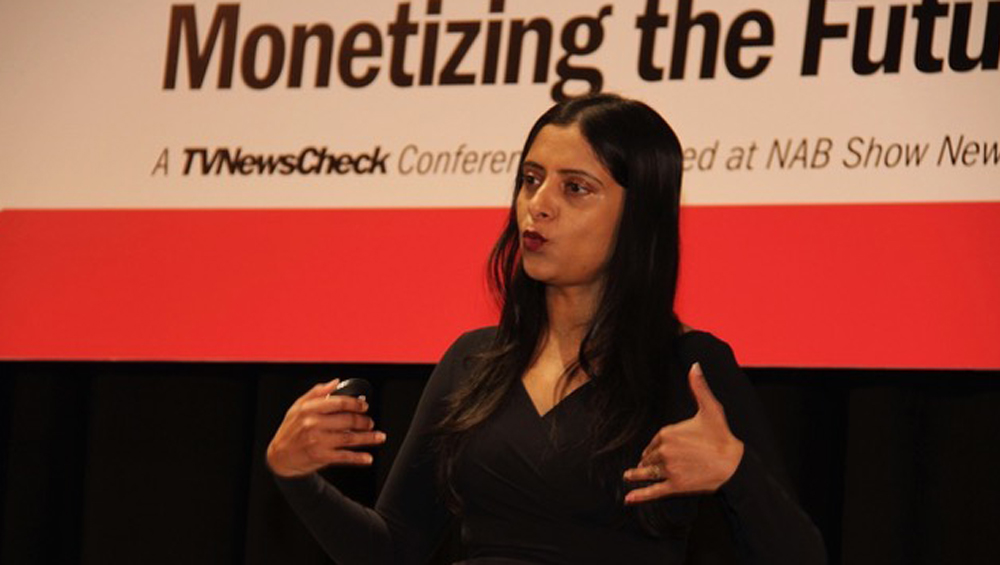In a presentation kicking off the TVNewsCheck’s annual TV2020 conference Wednesday morning, Radha Subramanyam, chief research and analytics officer at CBS, delivered a robustly positive message of growth in TV monetization, spurred in great part by the diversification across broadcasting that just a few years ago had so many insiders breaking out in a cold sweat during all hours of the night. (Photo: Wendy Moger-Bross)
By Michael Stahl
Source: tvnewscheck.com, October 2019
NEW YORK — It goes without saying that the broadcasting landscape is evolving at a feverish pace — with streaming services driving much of the change.
But in observing the industry from a bird’s eye viewpoint, the most vital of data remains relatively unchanged: People are still watching TV.
Industry players simply need to navigate shifting tides, manifested in the now widely varied platforms consumers use as TV delivery services, and embrace change by accepting the fact that there are more opportunities to monetize broadcasting than ever before.
Apparently they’re catching on.
In a presentation kicking off the TVNewsCheck’s annual TV2020 conference here Wednesday morning, Radha Subramanyam, chief research and analytics officer at CBS, delivered a robustly positive message of growth in TV monetization, spurred in great part by the diversification across broadcasting that just a few years ago had so many insiders breaking out in a cold sweat during all hours of the night.
“There’s movement at the margins,” Subramanyam said, presenting a slide that showed a mere one-minute decline in overall daily video viewership between 2018 and 2019, with increases in consumer use of alternative digital devices, such as smartphones and tablets. “There are always little shifts within, but ultimately it all works out.” She added that Nielsen data “is showing 100% stability over the past year.”
Subramanyam conceded that “time-shifting is a reality,” and the promise of monetization growth will rely heavily on model adjustments, with a retained “broadcast-first approach,” such as the one her company, CBS, continues to employ. And though content travels through so many different conduits today — syndication, international distribution, OTT, mobile and others — Subramanyam said that because the content still “intersect[s] all the time … the sum is greater than each of the individual parts.”
Her proof lay in another slide. Last year, direct-to-consumer (DTC) brands spent nearly $3.8 billion on TV in 2018, which was two and a half times more than the $1.52 billion spent just two years prior.
Though social media has transformed our culture in unquantifiable but certainly tremendous ways, fortunately for broadcasting people would still rather post about TV “than they would talk about diapers or even cars or anything like that,” Subramanyam said.
“If you actually look at all of the chatter that’s going on in social [media], you find much of it is TV-led and TV-driven,” Subramanyam observed. “While we [CBS] don’t primarily create for social [media] — we create for television, in a traditional sense — we’re also trying to think about how we manage our franchises, and manage the lives of these programs, because we know that they live in all of these different ways.”
Marketing providers should consider their roles in that form of content presentation as well, Subramanyam added.
Another positive truth that aids broadcasting, according to Subramanyam, is that even though the country is politically and socially divided — perhaps as staunchly as it’s been in two generations — Americans are aligned on what makes for worthwhile TV: quality storytelling, characters of depth, appealing presentation and authenticity when it comes to discussing issues in the country. As long as broadcasters stick to those core principles, she said, all signs indicate business will be just fine.
If anything frustrates Subramanyam it’s that TV “currency is evolving” and that there is no third-party measuring service currently offering a “total view of our total audiences.” Ratings are pieced together from a variety of sources, and some currencies are not measured at all, including VOD 8+ days, dynamic advertising insertion (DAI), out of home (OOH) and others. However, this is not a permanent state. Measurements of OOH, for example, is expected to be available next Sept. 1, and could particularly help with sports’ numbers, and there’s improved audience measurements elsewhere.
A momentary stretch of currency fragmentation aside, though, broadcasting remains a more-than-viable industry — and will continue to be for quite some time. In ending her time onstage, Subramanyam said in summation: “We do believe the future is opportunity.”
To read more TV2020 stories, click here

